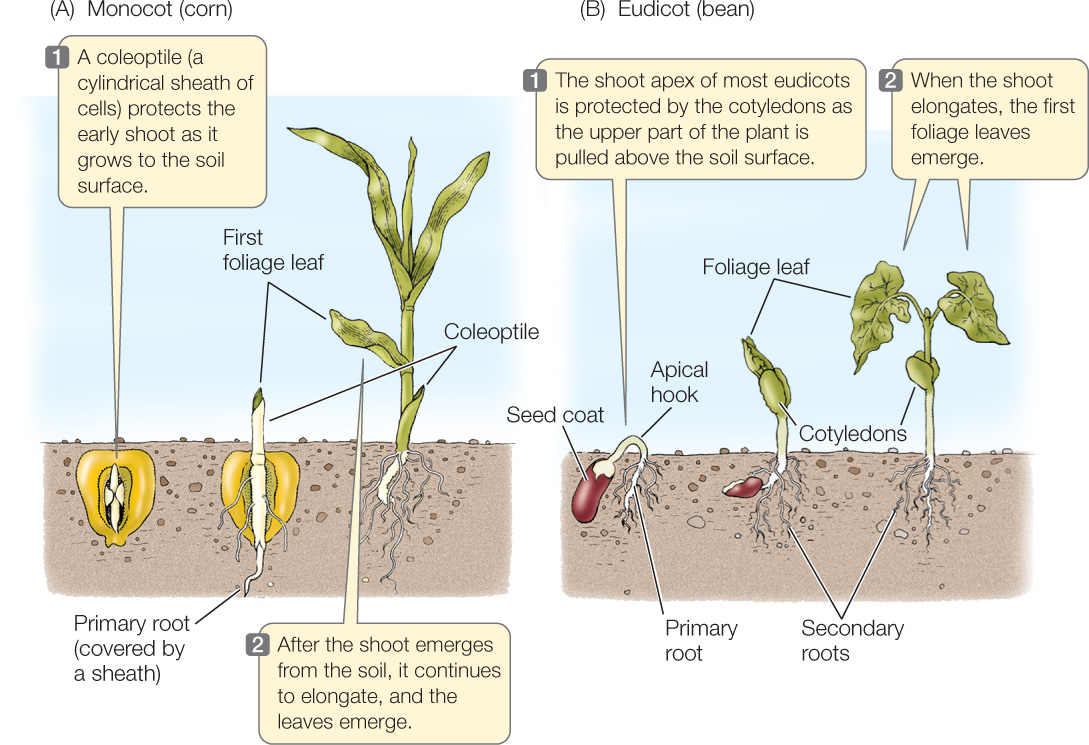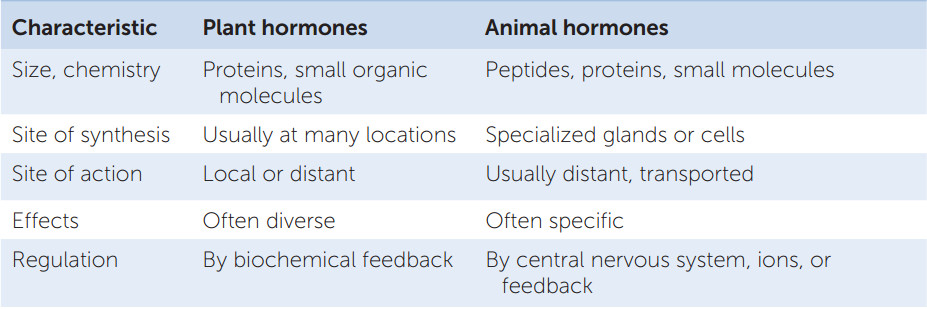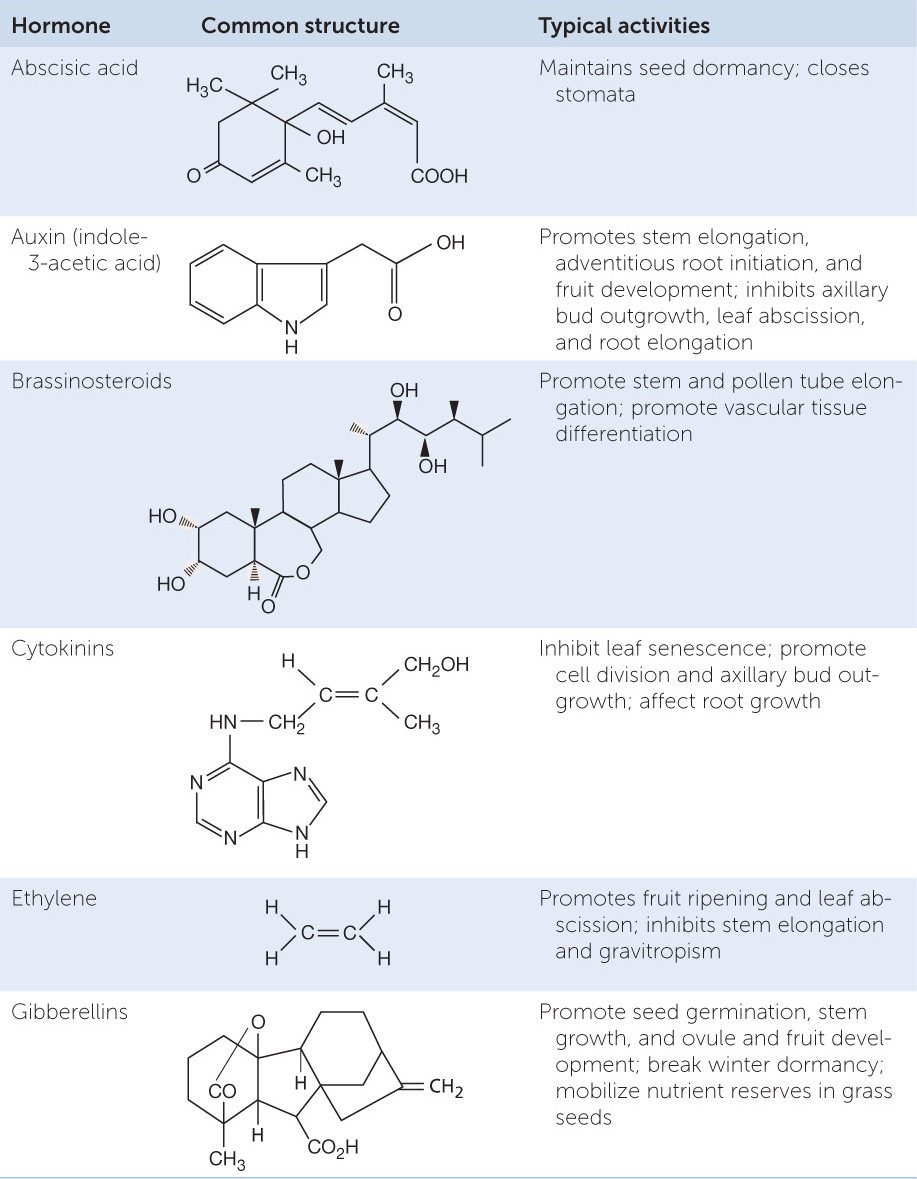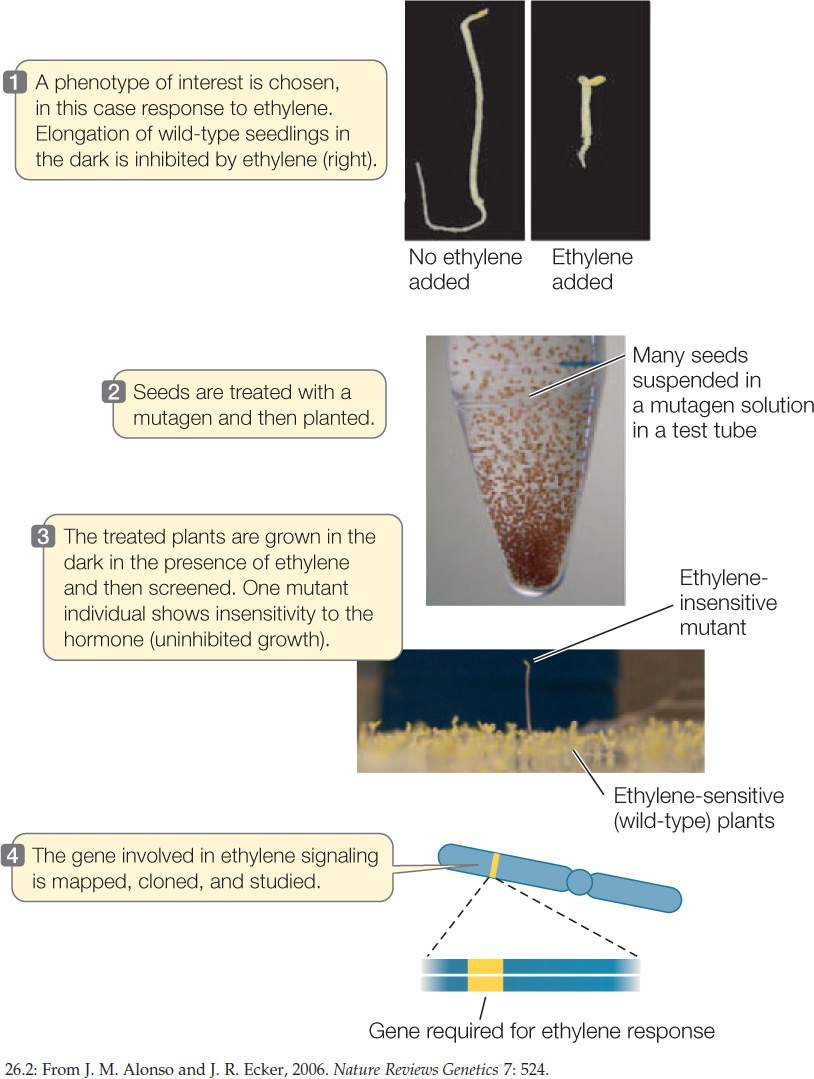CONCEPT26.1 Plants Develop in Response to the Environment
Plants are sessile (nonmobile) organisms that must seek out resources above and below the ground. Plants have several characteristics that distinguish them from animals and allow them to obtain the resources that they need to grow and reproduce:
- Meristems. Plants have permanent collections of stem cells (undifferentiated, constantly dividing cells) that allow them to continue growing throughout their lifetimes (see Concept 24.2).
- Post-embryonic organ formation. Unlike many animals, plants can initiate development of new organs such as leaves and flowers throughout their lifetimes.
- Differential growth. Plants can allocate their resources so that they grow more of the organs that will benefit them most—for example, more leaves to harvest sunlight or more roots to obtain water and nutrients.
The development of a plant—the series of progressive changes that take place throughout its life—is regulated in many ways. Several key factors are involved in regulating plant growth and development:
- Environmental cues, such as day length
- Receptors that allow a plant to sense environmental cues, such as photoreceptors that absorb light
- Hormones—chemical signals that mediate the plant’s adaptations and effects of environmental cues, including those sensed by receptors
- The plant’s genome, which encodes regulatory proteins and enzymes that catalyze the biochemical reactions of development
We will explore these factors in more detail later in this chapter. But first let’s look at the initial steps of plant development—from seed to seedling—and the environmental cues and internal responses that guide those steps.
The seed germinates and forms a growing seedling
Concepts 24.1 and 27.1 describe the events of plant development and reproduction that lead to the formation of seeds. Here we begin with the seed, the structure that contains the plant embryo. Unlike most animal embryos, plant embryos may be held in “suspended animation” inside the seed, with development halted, for long periods. If development stops, even when external conditions (such as water supply) are adequate for growth, the seed is said to be dormant. Development restarts when the seed germinates (sprouts).
Dormancy
Seed dormancy may last for weeks, months, years, or even centuries: in 2005, a botanist was able to germinate a date palm seed recovered from a 2,000-year-old storage bin at Masada in Israel. Plants use several mechanisms to maintain dormancy:
- Exclusion of water or oxygen from the embryo by an impermeable seed coat
- Mechanical restraint of the embryo by a tough seed coat
- Chemical inhibition of germination
- Photodormancy: some seeds require a period of light or dark to germinate
- Thermodormancy: some seeds require a period of high or low temperature to germinate
Dormancy can be broken by factors that overcome these mechanisms. For example, passage through an animal’s digestive system may damage the seed coat, or burial beneath soil (in darkness) might trigger germination.
Seed dormancy is a common phenomenon, so it must have selective advantages for plants. Dormancy ensures survival during unfavorable conditions and results in germination when environmental conditions are most favorable for growth and development of the young plant. For example, to avoid germination in the dry days of late summer, some seeds require exposure to a long cold period (winter) before they will germinate; this ensures that the plant has the entire growing season to mature. Dormancy also helps seeds survive long-distance dispersal, allowing plants to colonize new territory.
Germination
Seeds begin to germinate when dormancy is broken. For example, a seed may germinate after a germination inhibitor is washed away in heavy rain, which means the soils will have plenty of water and germination will be possible.
The first step in germination is the uptake of water, called imbibition (from imbibe, “to drink in”). A dormant seed contains very little water: only 5–15 percent of its weight is water, compared with 80–95 percent for most other plant parts. Seeds also contain polar macromolecules, such as cellulose and starch, that attract and bind polar water molecules. Consequently a seed has a very negative water potential (see Concept 25.3) and will take up water if the seed coat is permeable. The force exerted by imbibing seeds, which expand severalfold in volume, demonstrates the magnitude of their water potential. Imbibing cocklebur seeds can exert a pressure of up to 1,000 atmospheres (approximately 100 kilopascals, or 15,000 pounds per square inch).
As a seed takes up water, it undergoes metabolic changes: enzymes are activated, RNA and then proteins are synthesized, the rate of cellular respiration increases, and other metabolic pathways are activated. In many seeds, cell division is not initiated during the early stages of germination. Instead, growth results solely from the expansion of small, preformed cells.
As the seed begins to germinate, the growing embryo obtains chemical building blocks for its development—carbohydrates, amino acids, and lipid monomers—by hydrolyzing (see Figure 2.8) starch, proteins, and lipids stored in the seed. These reserves are stored in the cotyledons—embryonic leaves—or in the endosperm—a seed tissue specialized for storage. Germination is completed when the radicle (embryonic root) emerges from the seed coat. The plant is then called a seedling.
557
If the seed germinates underground, the new seedling must elongate rapidly (in the right direction!) and cope with a period of life in darkness or dim light. A series of photoreceptors direct this stage of development.
The pattern of early shoot development varies among the flowering plants. FIGURE 26.1 shows the shoot development patterns of monocots and eudicots. In monocots, the growing shoot is protected by a cylindrical sheath of cells called the coleoptile as it pushes its way through the soil. In eudicots, the shoot is usually protected by the cotyledons.

Several hormones and photoreceptors help regulate plant growth
This survey of the early stages of plant development illustrates the many environmental cues that influence plant growth. A plant’s responses to these cues are prompted and maintained by two types of regulators: hormones and photoreceptors. Both types of regulators act through signal transduction pathways (series of biochemical steps within a cell that occur between a stimulus and a response).
LINK
The general characteristics of signal transduction pathways are discussed in Concepts 5.5 and 5.6
Hormones are chemical signals that act at very low concentrations at sites often distant from where they are produced. Plant hormones are different from animal hormones (TABLE 26.1; see also Chapter 35). Each plant hormone plays multiple regulatory roles, and interactions among them can be complex. Several hormones regulate the growth and development of plants from seedling to adult (TABLE 26.2). Other hormones are involved in the plant’s defenses against herbivores and microorganisms (which we will discuss in Chapter 28).


Photoreceptors are proteins with pigments associated with them. Light acts directly on photoreceptors, which in turn regulate developmental processes that need to be responsive to light, such as the many changes that occur as a seed germinates and a seedling emerges from the soil. Note that this effect of light as an information source is different from the effect of light as an energy source in photosynthesis.
Genetic screens have increased our understanding of plant signal transduction
In Chapter 14 we described how genetic studies can be used to identify the steps along a developmental pathway. You will recall the reasoning behind these experiments: if a mutation in a gene involved in a certain biochemical process disrupts a developmental event, then that biochemical process must be essential for that developmental event. Similarly, genetic studies can be used to analyze pathways of receptor activation and signal transduction in plants: if proper signaling does not occur in a mutant strain, then the mutated gene must be involved in the signal transduction process. Mapping the mutated gene and identifying its function are starting points for understanding the signaling pathway. Arabidopsis thaliana, a member of the mustard family, has been a major model organism for plant biologists investigating signal transduction.
558
One technique for identifying the genes involved in a plant signal transduction pathway is illustrated in FIGURE 26.2. This technique, called a genetic screen, involves creating a large collection of randomly mutated plants and identifying those individuals that are likely to have a defect in the pathway of interest. Plant genes can be randomly mutated in two ways:
- By insertion of transposons (see Concepts 12.2 and 12.3) or T DNA (see Concept 13.2)
- By treatment of seeds with chemical mutagens, most commonly ethyl methane sulfonate or radiation
RESEARCH TOOLS

In both cases, the treated plants are grown and then examined for a specific phenotype, usually a characteristic that is known to be influenced by the pathway of interest. Once mutant plants have been selected, their genotypes are compared with those of wild-type plants. Mutant Arabidopsis plants with altered developmental patterns have provided a wealth of new information about the hormones present in plants and the mechanisms of hormone and photoreceptor action.
CHECKpointCONCEPT26.1
- Describe how monocots and eudicots differ in their early development.
- Seeds of the Australian shrub Acacia myrtifolia require extreme heat (fire) to germinate. How do you think fire might work as an environmental cue to break dormancy? What would be the selective advantage of this mechanism for breaking dormancy?
- Seedlings grown in the dark grow thin and tall, a phenomenon called etiolation. How would you set up a genetic screen using Arabidopsis to investigate the signaling pathway that controls etiolation?
With this overview of plant development, we will begin our examination of the specific regulatory mechanisms that underlie these events. Two hormones—gibberellins and auxin—have prominent roles in plant development.